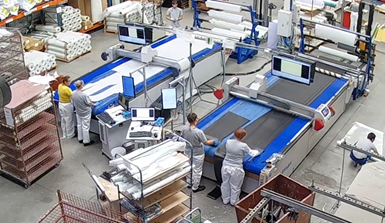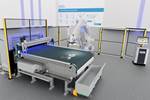Eastman Machine automated cutting equipment increases HanseYacht efficiencies by 85%
Since implementation of its first conveyorized cutting system, the recreational boatbuilder regularly seeks ways to improve its composite material handling processes.

HanseYachts’ cutting room is equipped with two duplicate spreading, cutting, and marking configurations. Photo Credit: Eastman Machine
Said to be one of the biggest producers of recreational sailing and motor yachts in the world, (Lozienica, Poland) regularly seeks ways to improve its processes, working with a variety of composite and advanced textile materials. After investing in automated cutting equipment from Eastman Machine Co. (Buffalo, N.Y., U.S.), HanseYachts increased efficiency by almost 85%.
HanseYachts’ first conveyorized cutting system was specifically purchased to replace the manual cutting of glass fiber. The implementation of automation increased efficiency by 44%.
“There was a revolution and a change in our technological processes,” Grzegorz Kaminski, HanseYachts Poland cutting room manager, says. “The result was an increase in the quality of the manufactured product. Reduction of waste, standardization and greater control over the production process were introduced.”
The Eastman cutter quickly became a vital member of the HanseYachts team. After seeing machine capabilities firsthand, the company began using the automated conveyor for a larger variation of materials — glass fiber, carbon fiber, Coremat and more.
With the development of its sixth brand, Ryck, HanseYachts implemented a second Eastman cutting system. The company wanted to support portfolio expansion by increasing productivity, maintaining quality and avoiding production bottlenecks. The additional system integration further increased efficiency by 38%..
“At Eastman, we understand the gravity luxury marine fabricators put into sourcing suppliers,” Elizabeth McGruder, VP of European sales and marketing, adds. “We are proud to work with a global giant like HanseYachts and look forward to the opportunities our partnership will bring.”
Related Content
-
Plant tour: Teijin Carbon America Inc., Greenwood, S.C., U.S.
In 2018, Teijin broke ground on a facility that is reportedly the largest capacity carbon fiber line currently in existence. The line has been fully functional for nearly two years and has plenty of room for expansion.
-
Bladder-assisted compression molding derivative produces complex, autoclave-quality automotive parts
HP Composites’ AirPower technology enables high-rate CFRP roof production with 50% energy savings for the Maserati MC20.
-
Welding is not bonding
Discussion of the issues in our understanding of thermoplastic composite welded structures and certification of the latest materials and welding technologies for future airframes.






